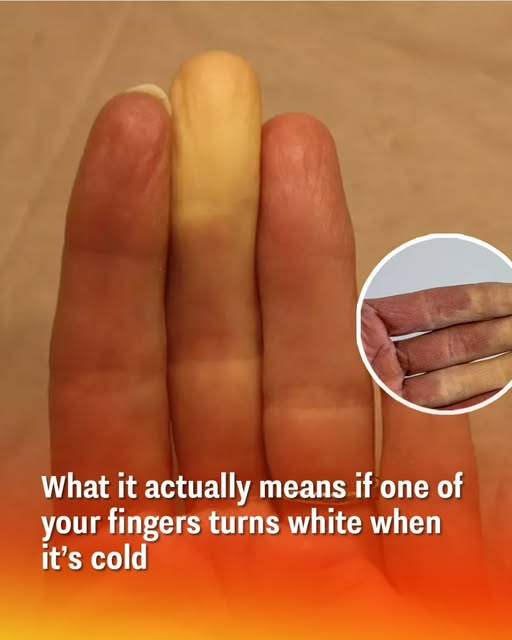
Do your fingers or toes have an extreme reaction to cold temperatures, changing colors and becoming numb or painful?
If so, you could be part of the 5 to 10 percent of the population that suffers from Raynaud’s syndrome.
While not usually dangerous, this condition can be a frustrating nuisance.
And even though it’s relatively common, there is still little known about the condition’s causes and there is no cure.
Raynaud’s syndrome (also referred to as Raynaud’s disease or Raynaud’s phenomenon) more often affects people who live in cold climates, and women are nine times more likely than men to be affected.
When a person with Raynaud’s syndrome is exposed to cold temperatures or stress, their blood vessels start to constrict, a phenomenon known as vasoconstriction, which prevents the blood from reaching the skin’s surface.
It most often affects the extremities such as the fingers and toes.
When the blood vessels shrink, the skin may turn white, blue or purple.
Later, when the blood starts flowing again the skin may turn red and start to tingle or throb.
Some people can experience these effects when temperatures are as high as 60 – 70 degrees Fahrenheit.
What Causes Raynaud’s Syndrome?
Sometimes Raynaud’s syndrome develops for no obvious reason; this is known as primary Raynaud’s.
In contrast, secondary Raynaud’s is caused by an underlying condition, such as lupus, rheumatoid arthritis or other connective tissue diseases.
It can also be caused by certain medications used to treat blood pressure, cancer, migraines and other conditions, as well as some over-the-counter cold and flu medications.
Raynaud’s Syndrome Versus Poor Circulation
Raynaud’s syndrome is a blood circulation problem, but it is different from what is commonly thought of as “poor circulation.”
Poor circulation generally affects older people and can be caused by underlying conditions such as plaque buildup in the arteries, high blood pressure, diabetes, obesity and heart and vascular issues, as well as lower activity levels.
Raynaud’s syndrome, on the other hand, can affect people that are younger and otherwise healthy.
The effects of a Raynaud’s attack are also generally short-term and can usually be prevented and/or resolved with lifestyle adjustments.
Preventing Raynaud’s Attacks
The best way to control the symptoms of Raynaud’s syndrome is to prevent episodes from occurring in the first place.
Ways to do this include bundling up in colder temperatures, concentrating on keeping your core and extremities warm.
You can also benefit from wearing thick socks and gloves or mittens, and using hand and foot warmers.
You should avoid things that can constrict the blood vessels, such as smoking, excessive amounts of caffeine, or the use of medications that cause vasoconstriction. It also helps to increase physical activity and wear extra layers in air conditioned environments.
How to Ease Symptoms
To ease symptoms once they start, you can try running your fingers or toes under warm (not hot) water until the blood starts flowing again and they return to a normal color. If you don’t have access to warm water, you can try putting your hands under your armpits to warm them up.
If lifestyle modifications aren’t enough to control Raynaud’s symptoms, there are certain medications that may be helpful. For instance, calcium channel blockers such as amlodipine can be prescribed in low doses to help improve blood flow to the fingers and toes.
If you suspect you have Raynaud’s syndrome, speak to your primary care provider. They can assess your symptoms and order blood tests that can help determine if an underlying condition is causing Raynaud’s syndrome, and can also help rule out other vascular or circulation problems.
Related Links
Whatever your age or stage of life, prevention is the best medicine.
That’s why it’s important to see your primary care provider for age-appropriate screenings and vaccinations that can prevent disease.
Focus closely—you’ll spot it

Eagle-eyed drivers spot rude number plate illusion hidden in plain sight

Car fanatics often dream of having a personalised number plate – but one driver has left people in stitches with their creative choice of digits.
The hilarious driver has gone viral on social media after they cleverly disguised a very rude word within their number plate – and you’ll likely be staring at it for ages trying to work out what it is.
The picture was posted on Facebook, and was taken in a Perth shopping centre car park.
At first glance, the number plate doesn’t appear to mean anything at all.
It just looks like your bog-standard offering.
But on closer inspection, you’ll spot a rather cheeky message.

The combination of ‘370HSSV’ seems completely innocent, right? But when you look at it upside down, you’ll discover it actually reads ‘a**hole’, leaving people in hysterics.
After finally getting it, commenters branded the plate “absolutely hilarious”, “impressive”, and “brilliant”, according to the Daily Mail.
Some admitted they’d struggled to see it until they “flipped” their device, and another shared that it was a “cunning trick”, noting that number plates that are deemed offensive usually get banned.
In the UK, many number plates have been banned by the DVLA for being too rude.
These plates include SH15 TTY, P15 OFF, WA15 TED, and JE55US.
Censorship decisions are taken by members of a DVLA steering group, who decide which number plates are the most offensive, and should therefore be banned.
However, some naughty registration plates slip through the net, as someone is driving around with the reg BO11 LUX.
In Australia, banned registration plates include RAMP4GE, and BUYAGRAM, which refers to purchasing drugs.